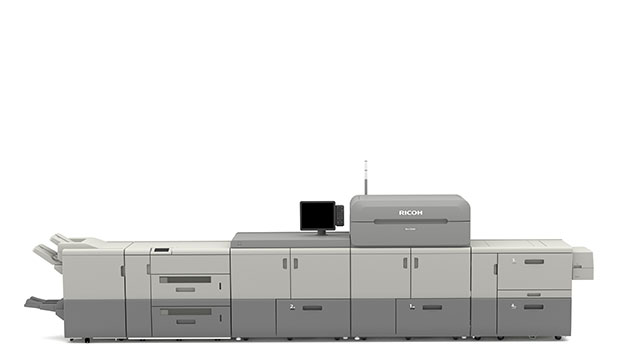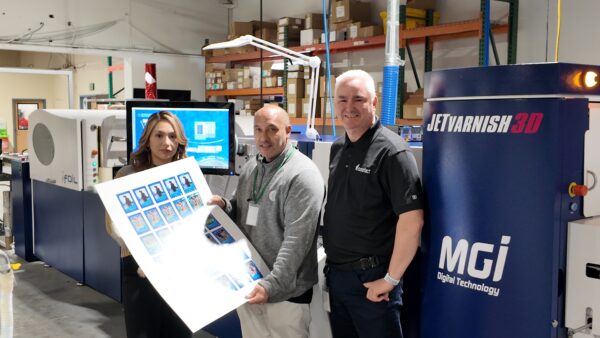Best practices for embarking on this potentially lucrative diversification opportunity.
How should office technology dealers get started selling production printers? This is the question that The Cannata Report posed to leaders at three dealerships—Advanced Imaging Solutions (Minneapolis), Les Olson Co. (Utah), and Virginia Business Systems —and three original equipment manufacturers (OEMs)—Konica Minolta, Ricoh, and RISO.
It may sound cliché, but to get buy-in, the commitment to selling production printers has to come from the top down, according to Troy Olson, owner and chief business development officer at Salt Lake City dealership Les Olson Co. “We researched the market and picked the right cut-sheet partner in Ricoh,” says Olson, whose 66-year-old firm has played for quite some time in the production and industrial print space. With annual sales of more than $60 million, the dealership employs some 315 people (50 of them in sales) at nine branches—eight in Utah and one near Las Vegas.
Co-owner and CEO James Olson, Troy’s cousin, cautions that service is a “different ballgame” for production printers: “There’s a learning curve, and additional training is required from the different equipment manufacturers.”
Nonetheless, opportunities are rife, and color production printers may be the smoothest path to navigating the higher volume production landscape, according to Stephanie Keating Phillips, director of solutions for Minnetonka, Minnesota-based Advanced Imaging Solutions (AIS). “Add color-critical, entry-level devices to your portfolio,” she recommended.
Which of your current customers has a central reprographics department (CRD)? Some vertical market opportunities prime for production printer volumes include education, government, and healthcare/pharma, according to John Fulena, national director of production and industrial printing, dealer sales for Konica Minolta Business Solutions U.S.A. However, he added, “dealers probably don’t want the stress of selling [equipment] to commercial printers. Their service and lease agreements often are too demanding, and click charges are lower.”
Mono vs. Color
“The black-and-white (monochrome) toner unit is gradually disappearing,” observed Andre D’Urbano, executive director of sales and marketing for manufacturer RISO, Inc. Still, there are opportunities in the monochrome space, maintained AIS’s Keating Phillips, especially in the 120-pages per minute (ppm) speed range.
“But it’s more about workflows than ‘speeds and feeds’ for black-and-white production printers,” said Keating Phillips, citing EFI’s Fiery front ends as one expeditor capable of running multiple digital devices from one RIP (raster image processor). Other software also can facilitate production workflows: Konica Minolta’s AccurioPro Flux program enhances print makereadies, while XMPie solutions assist with variable-data printing (VDP) applications for offers such as credit cards and insurance policies.
AIS has been selling production printers for 16 years. Its customers output pages up to 12×18-inches on a substantial amount of mono-color jobs that are finished with color covers either inline or offline. “We see different combinations of black-and-white ‘shells’ with color added for ballots, books, pamphlets, tests, and tickets,” revealed Keating Phillips.
Getting Started
“The most effective way to gain traction in production is to start with entry level and light production products, where the majority of opportunities lie,” said Brian Balow, dealer channel vice president of production print sales and solutions at Ricoh USA.
He explained the two types of production printer dealers: light production and production. “Light production dealers upsell high-speed A3 office MFPs to OEM-defined entry and light production products,” he noted, focusing primarily on small- and medium-sized businesses, as well as mid-market and public sector opportunities.
“Production dealers support enterprise customers and print service providers (PSPs) such as commercial and franchise printers. Growth-oriented production dealers invest in and capitalize on the mid- and high-production segment products, including both cut-sheet and inkjet platforms, such as graphic arts wide-format solutions.”
Once a dealer has a benchmark in the entry level and light production printer markets, Balow recommends taking advantage of the sales and marketing programs Ricoh offers to expand sales into the lucrative CMYK+ embellishment market with its flagship sheetfed solution, the Pro C9200 Series. “Dealers poised for more also have an excellent opportunity to expand into graphic arts wide-format solutions,” said Balow.
What products should dealers start with? “Moving into the production space starts with understanding the business needs of your customers and prospects, and balancing those needs with the type of production dealer you want to be,” advised Balow. Ricoh’s Pro C5300 Series, for example, is ideally suited for in-plant and commercial market opportunities.
Help Wanted: Production Print Specialist
Virginia Business Systems (VBS) prefers to groom production printer expertise internally from its marketing support, service, technical, and sales departments. “We promote from within and look for people with a thirst for knowledge,” explained Jim Dotter, president and chief executive officer of the $30-million office equipment dealership with 140 employees and 12 offices in southeastern Pennsylvania and Virginia. “A couple of our production SMEs [subject matter experts] were techs who came from the service side of the house.”
To curb internal conflicts, Dotter and his management team developed a compensation plan that splits commissions equally and allows competitive staffers to share in board credit recognition.
VBS also has transitioned account reps into the production side and hired some from other production facilities. “It’s a combination; we’ve done both,” said Dotter. Each dealership’s branch now features two fully trained and certified production printing technicians on their service teams.
AIS has leaned hard on its OEMs for production print support in the past. The dealer then became more proactive. “We hired people from commercial printing environments…and added a group of analysts who work specifically with production clients,” said Keating Phillips. For example, “one [analyst] works with clients who use RSA software, assisting with training and implementation. Another does machine set up, training, and troubleshooting.”
When pursuing vertical markets such as health care or finance, AIS subscribes to a team-selling approach. “We have a production liaison as part of our tech team,” said Keating Phillips.
It’s important to have highly skilled, production-certified technicians and a thorough commitment to service level agreements (SLAs), especially as the service expectations of production customers differ from typical enterprise customers. Having clear and distinct SLAs in place at install is critical. Identifying service technicians and leaders that can thrive in these environments is also essential to building a solid foundation. Once this commitment to service and sales is established, dealers can focus efforts on front-office production printer sales.
The dealer’s organizational structure should mirror everyone else selling production printers. Ricoh recommends that dealers employ a production sales specialist to assist the general line and major account reps in selling the product. These specialists use their experience and knowledge of the production space applications and workflows to help customers and prospects run current jobs more efficiently. They can also help bring outsourced jobs or printed via offset into the digital color arena. Embracing digital transformation is key to growing sales in this segment.
Ideally, the dealer’s specialist will understand the equipment, applications, and software involved. If that expertise is not available, dealers may want to consider employing an analyst that understands color management and solution software to ensure compliance across all types of job requests.
Prospecting Strategies
Existing clients represent the best initial prospects. “They know what to expect from us,” said Les Olson’s James Olson.
Dotter recommended finding out which clients are in-sourcing short-run jobs and capitalizing on the trust factor. “Your customers will be honest about how they’re handling certain types of jobs and who they’re doing business with,” said Dotter. “Don’t be afraid to review past opportunities where you’ve walked away and follow up professionally.”
James Olson pointed to clients with in-plant shops: “For years, we walked past these giant accounts with fleets of Ricohs on the floor.”
Ricoh’s Balow added that dealers should understand the key verticals in their territory and build a prospecting strategy out of that data. The strategy also should include a thorough understanding of customers’ interest levels in production solutions based on the key applications the industry supports. “For example, how many direct mail pieces does the local college or university send out each year to meet their admissions requirements? What regulatory documents are needed in the health care or financial space, and where are those documents produced?”
It is critical, too, to use customer relationship management (CRM) tools to build up your database of prospects. To educate prospects about production printers, many dealers use email campaigns and lunch-and-learn sessions. “It is important to execute a focused sales strategy to drive pipeline as well as a marketing strategy (that includes a digital marketing component) to raise awareness and generate leads,” said Balow.
AIS started dealing in production print by targeting school districts. “They have copiers everywhere so schools kind of became our niche,” said AIS’s Keating Phillips. The dealership saved one public school district $7 million within five years. “That kind of ROI opens eyes,” she noted. “We show people the math by conducting cost analyses of running a production print center in their district. Internal print shops require people and space, yes, but the bottom line is the financials.”
Often, the decision of whether or not to delve into production printing comes down to volume. “If your customer is printing 200,000 pages per month, it’s probably not a good fit for them,” said Keating Phillips. On the flip side, AIS has customers producing 10 times that amount, printing two million pages monthly inside centralized, in-plant production facilities with only a handful of service calls per month. “That kind of uptime enhances ROI big time,” emphasized Keating Phillips.
Ricoh also recommends providing field sales with focused “air support” to drive awareness and interest in the production printer market. “Dealers with a marketing department are invited to leverage Ricoh’s production marketing expertise to further their marketing efforts,” said Balow. “And, dealers without a marketing department may want to consider contracting with Ricoh for these services.”
Production Printer OEM Assistance
Ricoh’s production field sales team collaborates closely with its dealer/partners throughout the entire sales process, from prospecting and demonstrations to solutions building and closing. Konica Minolta, like Ricoh and other OEMs, offers sales support and rigorous tech training courses. Nine vertical-market trainers also are available, as are face-to-face seminars in New Jersey. Additionally, Escalation Systems Support (ESS) integration has been in place for approximately one year now. Another resource is Konica Minolta’s Graphic Communications & Industrial Print Playbook.
As part of its production printer growth strategy, VBS hosts periodic open houses with OEM support and assistance. The dealer also works with Konica Minolta and Xerox on high-level training classes for account managers and SMEs.
Lastly, dealerships can take advantage of manufacturer print showrooms. To enhance production gains and workflow, for instance, dealers often send job files and media to its OEMs in advance for inspection purposes. “We do this with the Ricoh Customer Engagement Center in Boulder, Colorado,” said Troy Olson, which is where Les Olson Co. is taking another group of customers this month for on-site presentations and demonstrations (which also can be done virtually).
Konica Minolta’s Customer Experience Center (CEC) in Ramsey, New Jersey, is another example of how a manufacturer is providing the resources to help its dealers enhance their production printer offerings and better engage with customers. The CEC really took off during COVID, providing dealers and their customers with virtual demos. Today, Konica Minolta dealers have the option of bringing customers to the facility or leveraging the company’s virtual demos. For dealers experienced selling production print or those just starting out, these types of facilities are a huge asset to see products in action and expand their knowledge of production print.





